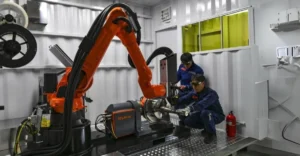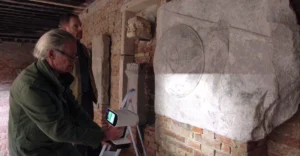Alquist 3D is transforming construction by 3D printing buildings using climate-specific concrete mixes, addressing housing shortages and sustainability challenges.
Alquist 3D is tackling America’s housing crisis head-on with one of the most ambitious, ambitious construction printing technologies — printing entire buildings from Walmart stores to affordable housing projects from new concrete printing.
Founded in 2020, by Zachary Mannheimer, the Greeley, Colorado-based firm has become a leader in 3D concrete printing (3DCP), proving its ability to build better buildings faster and cheaper than traditional approaches.
Walmart, for example, has an impressive project already under its belt. In Athens, Tennessee, the company Alquist 3D was able to 3D print a retail space of 8,000 square feet in around 45 days. While they initially struggled with heat and humidity, the team changed its concrete mix and worked with structural engineers to ensure their building matched fumes-seismic-rating-level standards.
A key challenge in 3D concrete printing is developing the right material. Unlike traditional concrete, 3DCP material must be fluid enough to print, strong enough to hold structural integrity, and quick-drying to enable efficient layering. Mannheimer notes that climate plays a crucial role, with different environmental conditions requiring unique concrete formulations.
At present, there are only eight major producers of 3DCP material in the world. Alquist is taking on this challenge by working with universities, private companies, and local governments to create climate-reactive, recyclable concrete mixes. They have set aggressive targets, including delivering concrete below $250 per cubic yard, over 7,000 psi strength, and a carbon-negative footprint.
The company’s technological evolution has been marked by strategic adaptations. Initially using a gantry-style printer, Alquist transitioned to a more flexible robotic arm system from RIC Technology. This switch improved printing speed, precision, and reduced operational downtime.
Alquist’s work reaches well beyond the limits of business construction as he has made great strides in residential buildings. In partnership with Habitat for Humanity, they constructed a 1200 sq. ft house in just 28 working hours in the year 2021. This feat is considered impossible to achieve with traditional commercial construction methods that would take weeks to complete. The house meets EarthCraft standards which certifies it’s robust, energy efficient, and disaster resilient.
And in the future, Alquist is installing an ambitious new 174-home affordable housing project known as Hope Springs, a plan set to break ground by 2029. The company is also looking at infrastructure uses, like 3D-printed stormwater curb systems in Greeley that show the flexibility of concrete printing technology.
Knowing that the industry is prone to scaling challenges, Alquist adopted some innovative strategies. They’ve rolled out a licensing program that lets other firms tap their expertise without heavy upfront costs. In addition, a collaboration with equipment dealer Hugg & Hall allows a rent-to-own 3D printer option that reduces entry barriers for new businesses.
Education is another critical focus. Alquist has collaborated with Aims Community College to develop an introductory 3DCP curriculum. The online course, launched in fall 2024, aims to train a new generation of builders familiar with both the craft and technology of 3D printing homes.
Mannheimer places his bet on workforce development as the driver of 3DCP’s future. He notes, “Most young people, for instance, do not want to swing a hammer in tough conditions – but they do appreciate the idea of operating a robot.” The business seeks to draw fresh resources into construction by marketing it as an industry that requires advanced 3D printing technology.
The bigger picture is quite fascinating. The U.S. is now dealing with a housing deficit of 5 million homes which 3D printing technology could potentially help solve. Alquist’s vision differs from the rest of the world as he aims to construct carbon negative concrete and maybe one day even print homes with recycled materials.
Regulatory ambiguity and industry skepticism are a few hurdles that still need to be addressed. In spite of this, Alquist has been actively collaborating with local authorities and proving the advantages of the technology while trying to remove the impediments to its integration.
In Mannheimer’s own words, and attempting to draw a parallel to ‘Back to the Future,’ the company imagines a future where construction materials can be harvested and recycled as easily as Doc Brown’s time travel fuel.
Focusing on collaboration, education, and sustainability, Alquist 3D is not simply erecting buildings; it is developing an architectural model for the future of housing and infrastructure.
































